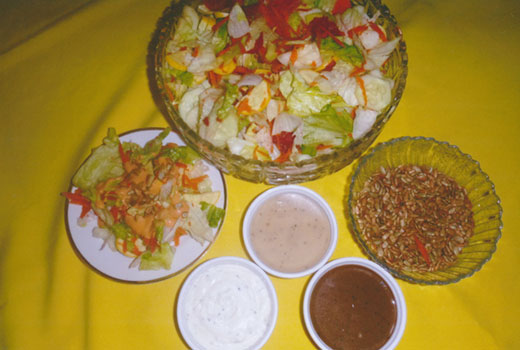So tell me, how many menus or recipes have you read which ended with “served with a green salad” or maybe “served with a green salad and hot rolls,” etc.?
This “green salad” is a staple of restaurants and should be so at your own dining room/kitchen table for several reasons: It is easy to prepare, it is usually inexpensive, it is pretty to serve, it takes only 10 minutes or so to make, the ingredients are almost always available at the grocery, and, most importantly, it is good for you.
One of the questions about such a useful and healthful salad is when to serve it. If you are serving a formal meal with courses of appetizer, soup, fish course, meat course, salad and dessert, then the salad would be served as a separate course following the main course and immediately before the dessert.
Most households — especially where both husband and wife work or a live-alone person eats — simply do not have such elaborate menus and serving practices, regardless of how proper the etiquette books tell you such serving is.
If eating in a restaurant, often you will have the salad served while the main dish you ordered is being prepared. I don’t know who thought of this schedule, but it was probably the idea of the chef so that the customers in the dining room would not get impatient while their food was being prepared.
Sometimes the leafy salad is served on the same plate with the meat and vegetables, especially if you are at a “meat and three” restaurant. This may mean stray lettuce leaves mix with the green beans. Sometimes it is served separately on a salad plate or in a bowl.
A salad of fresh vegetables needs a dressing. The simplest is oil and vinegar, usually mixed into the salad bowl before serving. There are others, often creamy in texture, which are also mixed with the green veggies before serving. Frequently, however, these are served separately, and each person spoons the dressing onto the salad greens after they find a home on his or her plate. These dressings include Thousand Island, Roquefort, Italian, Creamy Honey, French and Cucumber, among others.
A green salad is versatile. It can be a small amount served as part of your menu, or it can be the whole menu. By increasing the amount of ingredients, topping them with sliced boiled eggs, small chunks of baked chicken, thin strips of ham or other meat, and adding a roll, a nourishing lunch is created.
The basis of a green salad, of course, is the “green” part, and that most often is head lettuce. Tear the leaves into bite-sized pieces so they will (a) stay on your fork and (b) go into your mouth. You can cut the lettuce with a knife into slivers of whatever size you prefer, but some purists about salads say this is a no-no and that the leaves must be torn, not cut.
In addition to the most commonly used head lettuce, try butter lettuce, Bibb lettuce, arugula, fennel, dandelion, escarole, baby spinach and endive. Other greens include watercress, spinach, and the packages of mesclun (which is a collection of small, tender leaves of several plants).
After you select and prepare the green part of your salad, all kinds of good things can happen. It is best to use raw vegetables, but some ingredients such as pickled beets are an asset.
Consider these additions to the lettuce: chopped tomatoes, sliced baby squash, small asparagus tips, radishes, sliced or slivered carrots, broccoli, cranberries, sliced or diced apples, cucumbers, sliced mushrooms, etc.
Mix the greens and the additions together, tossing rather than stirring.
If you are using the oil and vinegar dressing, add it now and toss the salad lightly so that all the ingredients are covered.
If you are using one of the creamy dressings or if one of your guests prefers his dressing “on the side,” don’t mix the dressing with the salad ingredients but offer it in a glass bowl separately.
Whether or not you have mixed the dressing with the salad greens, a light sprinkling of sunflower seeds or walnuts on top makes a good finish.
If your guests are serving themselves, please provide salad tongs. These tongs have one side that is a large spoon and the other side is a large fork — just the thing you need for lifting the salad from its bowl.
So this weekend, if you are a little hungry (but not too hungry), take a few minutes to make a light and healthy green salad for your … Sunday Dinner.
(Correction: In our April 2015 issue, Rev. Tim Clark (pastor of Holly Springs Baptist Church, Inman) was incorrectly identified as Rev. Tom Clark. We apologize for the error.)
Creamy Honey Dressing: Combine in a jar or small bowl ½ cup mayonnaise, 1 tablespoon honey, ½ cup dairy sour cream, 2 tablespoons lemon juice, 1 tablespoon milk, and ½ teaspoon cooking oil. Stir well.
Simple Dressing: Crush one clove of garlic in 1 tablespoon salt, then blend in 2 tablespoons lemon juice, ½ teaspoon sugar, ¼ teaspoon pepper, ½ teaspoon celery seeds, ½ teaspoon paprika, and ¾ teaspoon dry mustard. Combine with 5 tablespoons salad oil in a jar and shake well.

